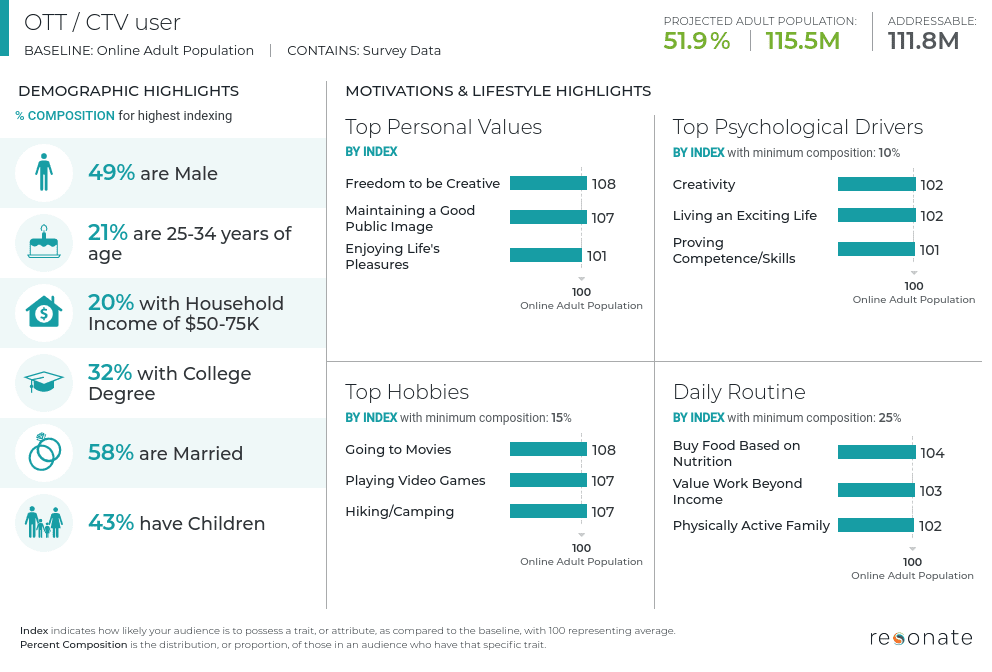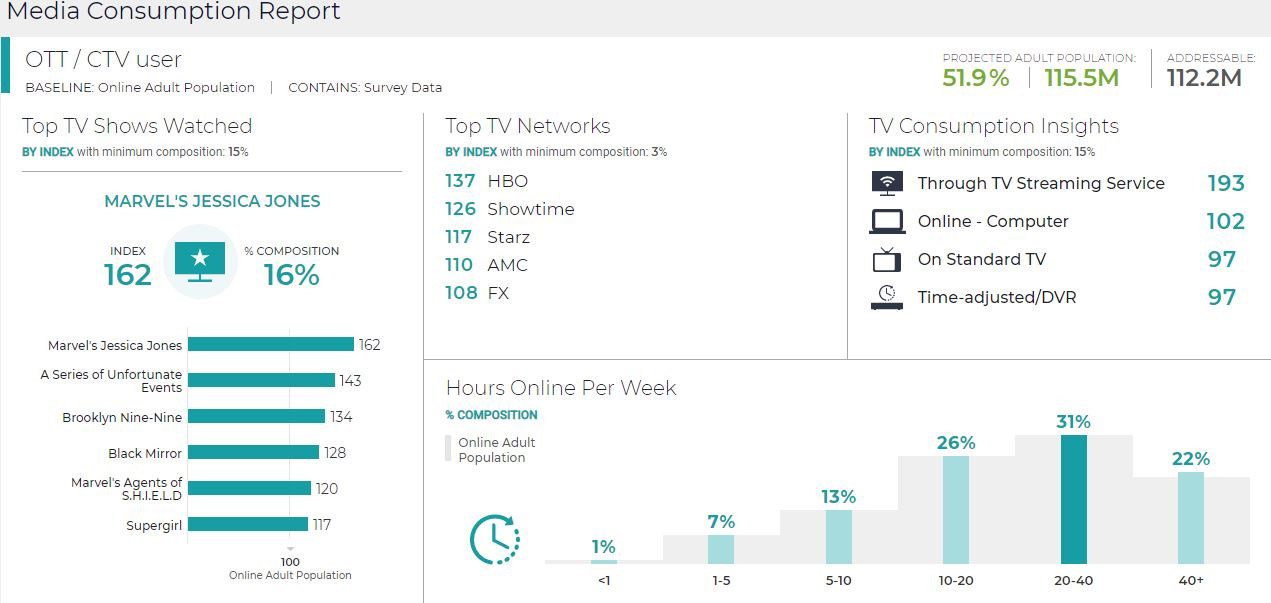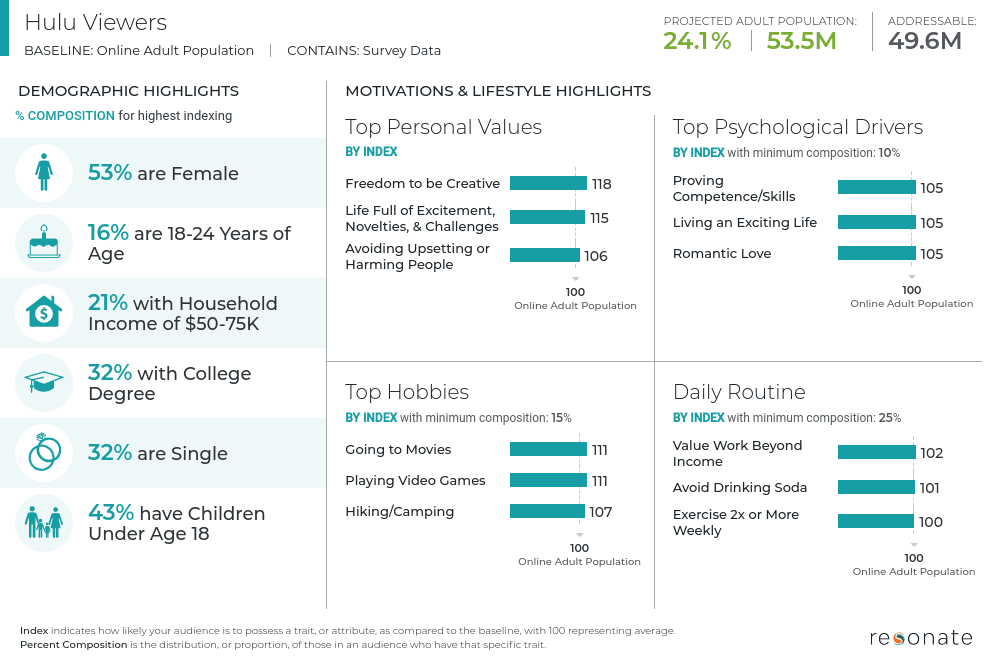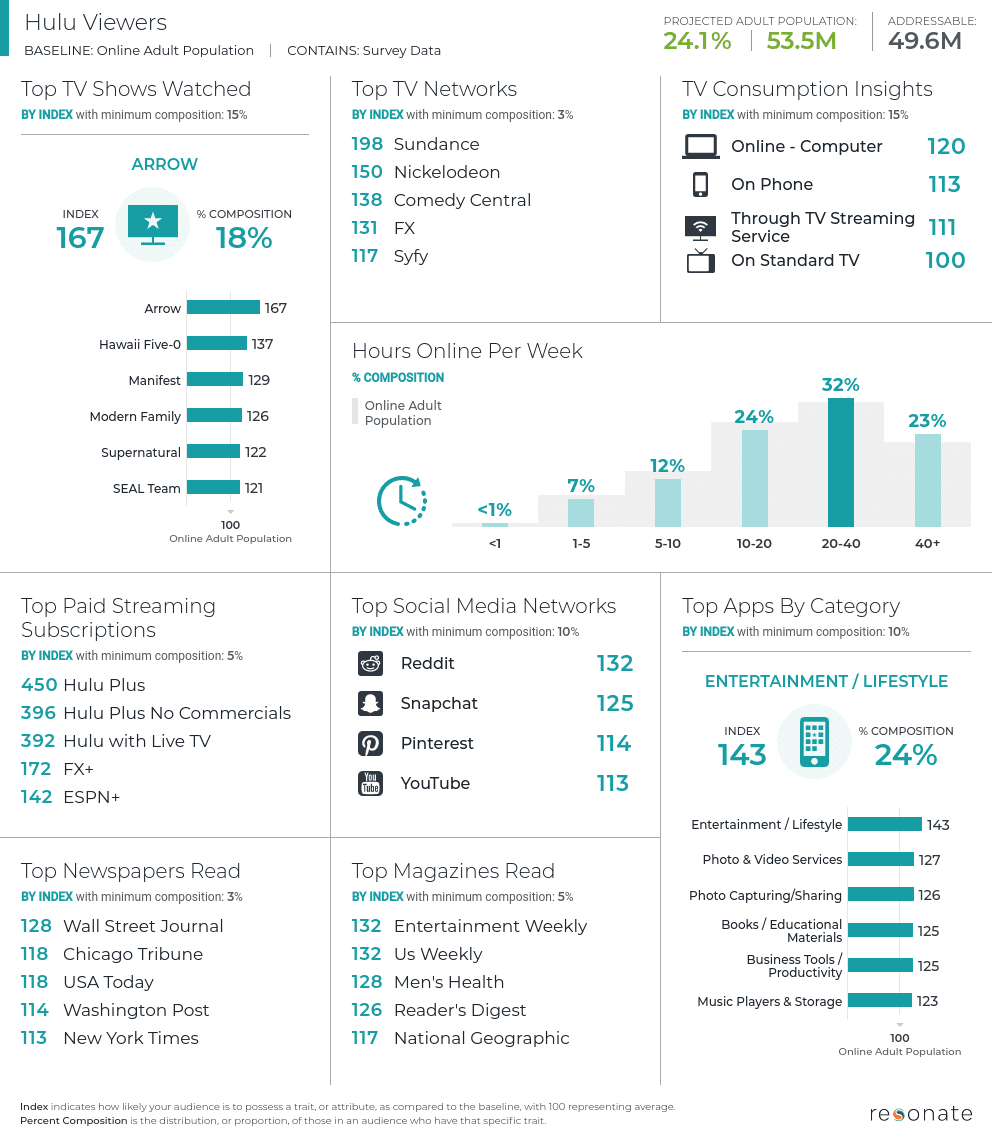More people than ever before are cutting the cord—53 million to be exact—with another 16.8 million considering it over the next three months. These consumers are moving to over-the-top (OTT) platforms, which provide access to TV shows and movies via the internet through services like Netflix and Hulu, without the need for a traditional cable subscription.
Connected TV (CTV) is a subset of OTT, but the content is only viewable on a TV (Roku, Apple TV, for example), whereas other OTT platforms can be viewed on tablets, iPhones and laptops. Not everyone who watches TV via a streaming service has cut the cord, but they’re 38% more likely to have done so.
With 52% of U.S. consumers streaming video content on an OTT or CTV app or device, it’s become an important channel for brands to reach customers and prospects, especially younger generations, as 21% of OTT/CTV users are ages 25-34. If you want a piece of the OTT/CTV pie, get in line. This market expanded 54% in 2018 and is expected to grow another 39% in 2019, making it the fastest-growing segment of the ad-supported media marketplace*.
Cable and satellite TV subscribers are declining at the highest rate since 2010*, while the playing field for ad-supported OTT and CTV apps and services is getting more crowded with companies like Apple, Disney and Target planning to launch services that will compete with the likes of Hulu and Amazon.
Effective OTT and CTV marketing requires brands and agencies to connect with consumers on a deep, individual level in order to boost conversion. With 12,000 insights on 200 million U.S. consumers, the Resonate platform has the right insights to successfully guide your OTT/CTV strategy.
Who is the OTT / CTV user?
Before formulating the right offers, messaging and creative, you need a holistic, person-level view of the 115.5 million OTT / CTV users.
Diving deeper than surface-level demographics, our insights reveal the powerful personal values that drive their daily decisions, including having the freedom to be creative, maintaining a good public image, being able to prove their competence and skills and enjoying life’s pleasures and living an exciting life. They value work beyond income, buy food based on nutrition and have physically active families. In their spare time they enjoy hiking and camping, going to the movies and playing video games.

These insights help shape a more complete understanding of the audience you are trying to motivate. Using them will inform better offers, as well as more compelling creative and messaging for an OTT/CTV campaign.
Where can you reach them?
Wondering which channels to work with? OTT / CTV users watch HBO, Showtime and Starz more than any other networks, and 31% of them spend 20-40 hours online every week. Do you know which device partners best fit your strategy? OTT / CTV users prefer Google Chromecast, Amazon Fire TV Stick and Roku as their CTV devices, and they’re 19% more likely to binge-watch shows.
Do you know which shows appeal to your target audience? In general, OTT / CTV users’ favorite TV shows are Marvel’s Jessica Jones, A Series of Unfortunate Events and Brooklyn Nine-Nine. Their weekday viewership occurs between 6:30 p.m. –7:00 pm. On the weekends, these users are tuned in between 12:00 p.m. – 5:00 pm. Keep these viewership preferences, devices and times in mind to get the most effective results while devising your media strategy.

Ad-Supported Streaming Services
While not all streaming services offer advertising opportunities (i.e. Netflix), the future of OTT/CTV is certainly moving that way. With media conglomerates like NBCUniversal, Disney and Viacom joining the ad-supported OTT/CTV market in 2019, Netflix and other ad-free streaming services may lose out on some of their most valuable content. For example, The Office was Netflix’s most-streamed show of 2018, but with NBCUniversal’s free, ad-supported streaming service launch, its fate on Netflix remains unknown.
Consumer sentiment appears to be shifting back as more consumers are becoming open to viewing ads if they can pay a lower monthly fee and view content whenever they want. Hulu proved consumers don’t mind ads as much as they used to when it announced last year that it had 40% more viewers on its ad-supported service year over year. Their ad revenues are expected to surpass $500 million by 2020*.
“Pure subscription services like Netflix will, at some point, have to resort to additional monetization options (i.e. advertising),” predicted eMarketer principal analyst Paul Verna.
What Are the Benefits of OTT / CTV Advertising?
OTT/CTV apps and devices allow brands and agencies to highly target both broad and specific demographics with high accuracy. Being an internet-based platform, OTT and CTV advertisers have access to gender-specific, age-specific and and other rich data on an individual level*, a capability traditional TV lacks.
An OTT/CTV advertiser will know where to reach viewers based on the streaming service they’re watching. If a viewer is watching a service that’s mainly centered around cooking and baking, a meal subscription company will want to place their ad there. Viewers are more likely to be engaged with an ad if it appeals directly to their interests and hobbies. According to a 2017 study, streaming TV viewers finish 98% of all video ads*. Deeper consumer insights help ensure that the creative, messaging and offers are appropriately targeted to this specific audience.
Another big benefit is that the ad serving technology cuts down on duplicative ads. They also run high-quality, well-produced commercials in a safe environment.
Let’s take a deeper look at Resonate’s insights on Hulu viewers.
Hulu Viewers: Who Are They and What Makes Them Unique?
As the most popular of the ad-supported streaming services, having a deeper understanding of Hulu viewers helps effectively guide brands and agencies to develop an effective OTT/CTV ad strategy.
Hulu viewers are college-educated women who are ages 25-44 and married without children. Resonate insights reveal they value the freedom to be creative, they lead a life full of excitement, novelties and challenges, they want to avoid upsetting or harming people.
They work out regularly, avoid drinking soda and value work beyond income. In their spare time, they enjoy hiking and camping, going to the movies and playing video games.

When developing ads specifically for Hulu, highlight themes of living a creative and exciting life. They’ll likely connect more deeply with ads that revolve around romantic love, being respected and proving their skills and abilities.
Hulu Viewers: Where Can You Reach Them?
Hulu viewers are most likely to watch TV on a computer or phone (so don’t target them on a tablet), and 32% of them spend 20-40 hours per week online. Not surprisingly, they’re 29% more likely to binge watch shows. The majority of their weekday viewing time happens between 12:00 am – 6:00 am, while their weekend viewership happens between 10:00 am – 3:00 pm. While planning out your ad strategy, be sure to take advantage of these preferences, times and devices.

Deep, individual-level insights on Connected TV users is critical for developing a successful advertising strategy. Resonate’s managed media services help agencies build, target and activate exact audiences at scale, powered by accurate and proprietary AI-driven data. Our dedicated team of experts is ready to amplify your Connected TV strategy by unearthing multi-attribute segments that will take your campaigns to the next level with unprecedented depth of data. As a result, you’ll exceed critical KPIs and dazzle your clients.
Start running your media on Resonate’s best-in-class data today. Learn more with our one-page guide.
*Magna Global, eMarketer, MarTech Series



